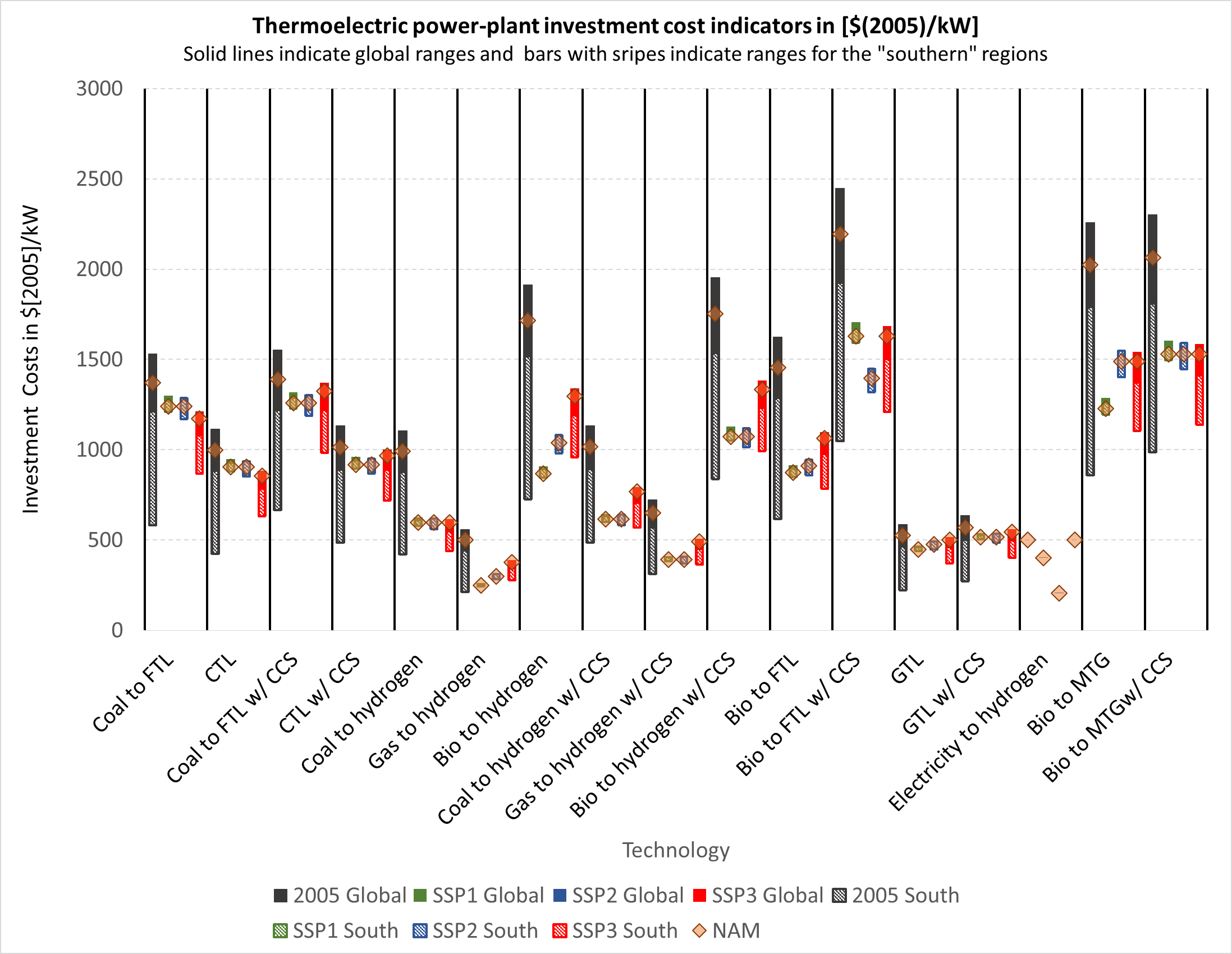Other conversion
Beyond electricity and centralized heat generation there are three further subsectors of the conversion sector represented in MESSAGE, liquid fuel production, gaseous fuel production and hydrogen production. Fig. 11 provides an overview of the investment cost ranges for these conversion technologies. The black bars show historical cost ranges for 2005. Green, blue, and red bars show cost ranges in 2100 for SSP1, SSP2, and SSP3, respectively. Global values are represented by solid ranges. Values in the global South are represented by dashed ranges. The diamonds show the costs in the “North America” region.

Fig. 11 Cost indicators for other conversion technology investment (Fricko et al., 2017 [17]) Abbreviations: CCS – Carbon capture and storage; CTL – Coal to liquids; GTL – Gas to liquids; BTL – Biomass to liquids.
Liquid Fuel Production
Apart from oil refining as predominant supply technology for liquid fuels at present a number of alternative liquid fuel production routes from different feedstocks are represented in MESSAGE (see Table 14). Different processes for coal liquefaction, gas-to-liquids technologiesand biomass-to-liquids technologies both with and without CCS are covered. Some of these technologies include co-generation of electricity, for example, by burning unconverted syngas from a Fischer-Tropsch synthesis in a gas turbine (c.f. Larson et al., 2012 [47]). Technology costs for the synthetic liquid fuel production options are based on Larson et al. (2012) [47].
Energy Source |
Technology |
Electricity cogeneration |
|---|---|---|
biomass |
Fischer-Tropsch biomass-to-liquids |
yes |
Fischer-Tropsch biomass-to-liquids with CCS |
yes |
|
Gasoline via the Methanol-to-Gasoline (MTG) Process |
yes |
|
Gasoline via the Methanol-to-Gasoline (MTG) Process with CCS |
yes |
|
coal |
Fischer-Tropsch coal-to-liquids |
yes |
Fischer-Tropsch coal-to-liquids with CCS |
yes |
|
coal methanol-to-gasoline |
yes |
|
coal methanol-to-gasoline with CCS |
yes |
|
gas |
Fischer-Tropsch gas-to-liquids |
no |
Fischer-Tropsch gas-to-liquids with CCS |
no |
|
oil |
simple refinery |
no |
complex refinery |
no |
Gaseous Fuel Production
Gaseous fuel production technologies represented in MESSAGE are gasification of solids including coal and biomass. In both cases carbon capture and storage (CCS) can be combined with the gasification process to capture to a good part the carbon that is not included in the synthetically produced methane. Table 15 provides a listing of all gaseous fuel production technologies.
Energy Source |
Technology |
|---|---|
biomass |
biomass gasification |
coal |
coal gasification |
Hydrogen Production
A number of hydrogen production options are represented in MESSAGE. These include gasification processes for coal and biomass, steam methane reforming from natural gas and hydrogen electrolysis. The fossil fuel and biomass based options can be combined with CCS to reduce carbon emissions. Table 16 provides a full list of hydrogen production technologies.
Energy source |
Technology |
Electricity cogeneration |
|---|---|---|
coal |
coal gasification |
yes |
coal gasification with CCS |
yes |
|
biomass |
biomass gasification |
yes |
biomass gasification with CCS |
yes |
|
gas |
steam methane reforming |
yes |
steam methane reforming with CCS |
no |
|
electricity |
electrolysis |
no |